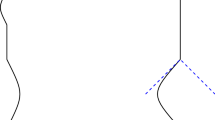I examine the changing attitudes of Oskar Klein (1894–1977) and Albert Einstein (1879–1955) toward the notion of extending general relativity by an extra dimension with the aim of encompassing electromagnetism and gravitation in a unified field theory. I show how Klein developed his model of five-dimensional unification with the goal of explaining the discreteness of atomic energy levels, and how Einstein later embraced that goal. By examining the correspondence between Klein and Einstein, some of which was relayed through Paul Ehrenfest (1880–1933), I speculate that Klein’s work helped motivate Einstein to explore deterministic five-dimensional theories as a potential alternative to probabilistic quantum mechanics. Finally, I consider the contributions of Wolfgang Pauli (1900–1958) to the subject and elucidate his role in convincing Klein and Einstein that their models were not viable.
Similar content being viewed by others
Author information
Authors and Affiliations
Corresponding author
Additional information
Paul Halpern is Professor of Physics at the University of the Sciences in Philadelphia. He currently is a member of the Executive Committee of the Forum on the History of Physics of the American Physical Society.
Rights and permissions
About this article
Cite this article
Halpern, P. Klein, Einstein, and Five-Dimensional Unification. Phys. perspect. 9, 390–405 (2007). https://doi.org/10.1007/s00016-006-0319-x
Published:
Issue Date:
DOI: https://doi.org/10.1007/s00016-006-0319-x




